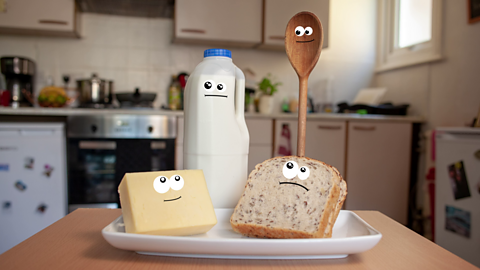How do we get energy from food and drink?
We all need energy for our bodies to grow and heal and so we can stay active. We get that energy from what we eat and drink.
In this article you can learn:
- how much energy we get from food
- how we measure energy from food
- what Basal Metabolic Rate (BMR) is
- the difference between simple and complex carbohydrates
This resource is suitable for Health and Wellbeing for primary school learners.
Video - Food as fuel
In this video, different kinds of food are running a race to find out which food is a good energy source. Learn about how different foods fuel our bodies in different ways.
Find out how different foods provide us with energy.
THE GREAT SPOON Ladies and gentlemen, knives and forks, a very warm welcome to this year’s energy race! All food releases energy - some quickly, some slowly. Let’s put this grub to the test! Joining me in the commentary box today is Masher. How are you doing Masher?
MASHER I’m excellent thank you, pal. This is an exciting race.
THE GREAT SPOON Yes, indeed. Everything in a human body uses up energy: from running to breathing to sleeping! To be healthy they need to put into their body the same amount of energy that they use up.
MASHER Fast releasing energy foods give humans a quick boost. Slow releasing energy foods are even better as they provide humans with energy for longer.
THE GREAT SPOON The best way to tell who is a fast releasing food and who is a slow releasing food is to make everyone race! Let’s see who has the energy to keep going!
MASHER In lane 1, we have Pineapple, a huge unit ripe for the challenge. In lane 2, Egg is ready to barrell down the track.
THE GREAT SPOON In lane 3, Sweet Potato looms large. In lane 4, at a massive 240 calories, it’s Chocolate Bar. And lastly in lane 5, hoping he doesn’t slip on his own skin, it’s Banana!
MASHER Let’s race down the kitchen table! Are you ready, food?
ALL CHEER
THE GREAT SPOON On your marks,
MASHER Get set
THE GREAT SPOON Go!
MASHER And they’re off, Chocolate Bar is already zooming ahead! But will he be able to keep it up?
CHOCOLATE BAR Wheeeeeee! Look at me go!
THE GREAT SPOON Remember, it’s not about speed, it’s about how long you can keep going. I’m worried Chocolate Bar is going to use up all his energy!
MASHER Pineapple is not too far behind Chocolate Bar. Maybe she can pace herself better.
THE GREAT SPOON Going at their own gentle paces are Egg, Banana and Sweet Potato.
CHOCOLATE BAR Feeling… quite… tired…
MASHER Oh! And would you look at that! Chocolate Bar has dropped out! Looks like he’s used up all his energy!
THE GREAT SPOON Oh, and Pineapple is out too! Just couldn’t keep it up.
MASHER They are high in sugar which gives a big burst of energy but doesn’t keep people going for a long time.
CHOCOLATE BAR So we’re just as good as each other?
PINEAPPLE We both have lots of sugar energy, but I’m healthier – I’ve got lots of vitamins too.
CHOCOLATE BAR IS OUT OF BREATH
THE GREAT SPOON Sweet Potato is plodding along in her own merry way. She’s a complex carbohydrate who takes longer to digest. So she releases energy very slowly.
SWEET POTATO WHISTLES
MASHER And just like that, Banana has used up all his energy and he’s out of the race.
BANANA PANTING
THE GREAT SPOON Egg and Sweet Potato are battling it out for the top spot. That’s the powerful protein in eggs, pushing him through.
MASHER He’s struggling, he’s struggling, and Sweet Potato hasn’t even broken a sweat.
THE GREAT SPOON And with that, Egg is out of the race and Sweet Potato is the winner!
SWEET POTATO Yeah!
MASHER Congratulations, Sweet Potato. You release energy the slowest helping power people through the day!
PINEAPPLE But wait a minute, me and Chocolate Bar were the fastest!
MASHER At first, yes. When food is eaten it is broken down which releases the energy inside it and powers the human. Some foods release their calories slowly and some do it quickly.
CHOCOLATE BAR And that’s why I lost?
THE GREAT SPOON Exactly!
BANANA So… humans should only eat sweet potatoes?
MASHER AND THE GREAT SPOON Oh Banana!
THE GREAT SPOON Humans should eat a mix of different foods! Starchy carbohydrates are a great way for humans to get energy to keep them going longer, but you are all valuable and give humans lots of energy! In fact, you all get medals!!
ALL CHEER
How do we measure energy in food?
- We measure energy in Sorry, something went wrongCheck your connection, refresh the page and try again..
- We can work out how much energy our food is giving us by looking at nutrition labels.
- To find out how much energy food provide, look for kcal or cal on packaging.
What do we need energy for?
About half of the energy we get from our food is used for things like:
- growing
- healing
- regulating our body’s temperature
These are all know as bodily functions and are measured using a Sorry, something went wrongCheck your connection, refresh the page and try again. (BMR).
What is the Basal Metabolic Rate (BMR)?
BMR is the measurement of the energy the body requires to function when it is resting.
Our bodies are amazing. Even when we are physically still, our bodies are busy on the inside and this requires energy. Everyone’s BMR is at a slightly different rate because we are all unique.
Find out more about our body systems with 2nd level Science.
Physical activity
The rest of the energy is used for physical activities. These range from:
- very energetic ones like walking, dancing, running, playing football.
- to less energetic activities like tidying up your bedroom, watching television and even sleeping
The more active you are the more calories you need to consume to keep up your energy levels. Every day we need to eat and drink to replace the energy we have used.
Imagine a car…
…the more petrol in the tank the further it can drive. Our bodies are no different. We can’t expect to have energy if we are not eating a healthy balanced diet to fuel them.
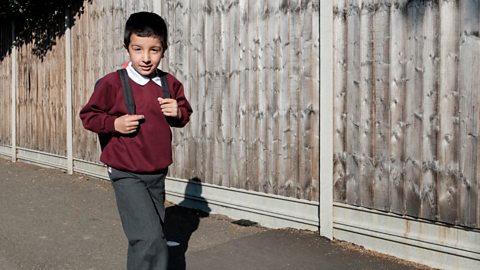
Image caption, Walking to school
Our bodies need fuel to walk to and from school so it's important we eat a healthy varied diet to help power those steps. (RayArt Graphics / Alamy Stock Photo)
Image caption, Running around during P.E. lessons
Exercise burns lots of your body's energy. Complex carbohydrates are great for powering you through P.E. lessons. Eating protein, like eggs or fish, will also help repair your tired muscles after you've exercised. (Jonathan Goldberg / Alamy Stock Photo)
Image caption, Doing school work
Energy isn't just needed for physical exercise, like walking and running. Your brain also requires lots of energy to solve problems, make decisions and even do your school work. (Paul Doyle / Alamy Stock Photo)
Image caption, Playing at the park
When you're playing at the park, you're probably using up lots of energy and getting a little out of breath. Eating slow releasing energy foods will help you play for longer without getting quite as tired. (Rachel Husband / Alamy Stock Photo)
Image caption, Sleeping
It might seem unbelievable that our bodies need energy to sleep but it's true! Our bodies grow and repair when we sleep at night. All this work requires energy that we get from food. We even need energy to dream! (BSIP SA / Alamy Stock Photo)
1 of 5
How do our food choices affect our energy?
Some foods release energy slowly and others release energy quickly.
Complex carbohydrates
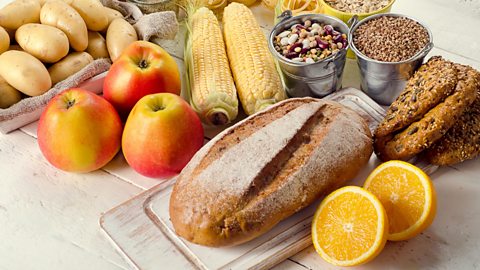
Slow releasing energy foods are called Sorry, something went wrongCheck your connection, refresh the page and try again..
- Complex carbohydrates, also known as starch, can be found in bread, pasta, flour and rice.
- The wholemeal varieties of these are the healthiest for us because they contain more fibre and less sugar.
- Complex carbohydrates also include vegetables such as sweet potato, spinach and parsnips.
- Complex carbohydrates release energy slowly and take time to digest which help us feel fuller for longer.

Simple carbohydrates

Fast releasing energy foods are known as Sorry, something went wrongCheck your connection, refresh the page and try again..
- Simple carbohydrates release their calories very quickly.
- Simple carbohydrates are foods high in sugar.
- Foods like chocolate, biscuits, fizzy drinks and some fruits give us a quick burst of energy but can then leave us feeling tired and hungry.
- They can also have an unhealthy impact on our blood sugar levels leaving us feeling overly tired.
- Although some fruits, like grapes or bananas, are full of natural sugars, they are also full of vitamins, minerals and fibre unlike sweeties.

Test your knowledge
Food and energy quiz
Try the quiz below. Can you work out the difference between slow releasing energy foods (complex carbohydrates) and fast releasing energy foods (simple carbohydrates)?
Challenge - food and energy
- Choose three foods you can find in your kitchen.
- Imagine you were running a race.
- Which out of the three foods would give you the most energy to run the race?
- Remember you will need slow releasing energy to finish the race.
More on Food and health
Find out more by working through a topic
- count3 of 10
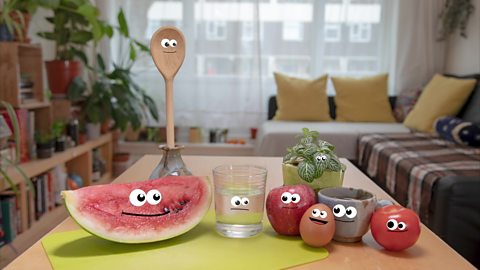
- count4 of 10
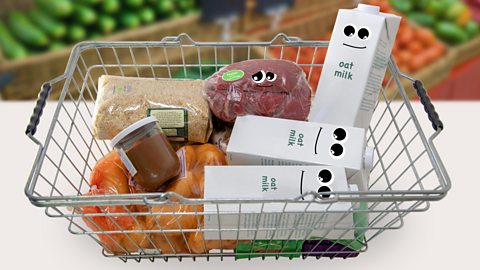
- count5 of 10
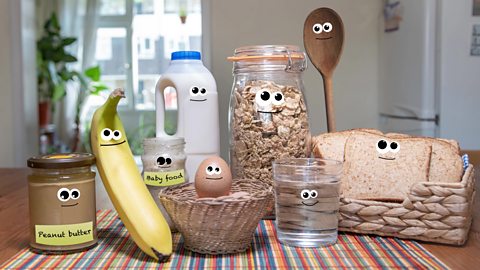
- count6 of 10
